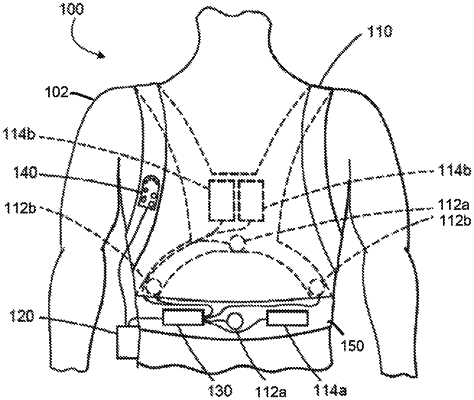| CPC G16H 50/30 (2018.01) [A61B 5/0205 (2013.01); A61B 5/349 (2021.01); A61B 5/681 (2013.01); A61N 1/3925 (2013.01); G16H 10/60 (2018.01); A61B 5/316 (2021.01); A61B 5/6815 (2013.01); A61B 5/6822 (2013.01); A61B 5/683 (2013.01); G16H 40/63 (2018.01); G16H 50/20 (2018.01)] | 25 Claims |

|
1. A medical device for assessing risk of patient deterioration comprising:
a memory storing data identifying
a plurality of presentable clinical conditions,
an indication, for each presentable clinical condition of the plurality of presentable clinical conditions, of whether the presentable clinical condition was presented to a healthcare provider,
a plurality of predictive risk assessment processes associated with the plurality of presentable clinical conditions, and
a corresponding plurality of clinical criteria associated with the plurality of predictive risk assessment processes;
a plurality of sensing electrodes configured to couple externally to a skin of a patient and to acquire electrocardiogram (ECG) signals;
one or more physiologic sensors distinct from the plurality of sensing electrodes and configured to couple externally to the patient and configured to acquire one or more physiologic signals distinct from the ECG signals;
a user interface configured to display prompts to a user of the medical device; and
a housing comprising
the memory,
the user interface, and
at least one processor coupled to the memory, the plurality of sensing electrodes, the user interface, and the one or more physiologic sensors, the at least one processor being configured to
generate ECG data over a predetermined period of time based on the ECG signals,
generate physiologic data over the predetermined period of time based on the one or more physiologic signals,
receive at least one of medical history and demographic information of the patient,
store the ECG data, the physiologic data, and the at least one of medical history and demographic information in a vector,
update a first portion of the vector continuously, update a second portion of the vector periodically, and update a third portion of the vector in response to one or more of admission to a first healthcare facility, transfer between locations within the first healthcare facility, transfer from the first healthcare facility to a second healthcare facility, or transfer from a first location to a second location,
identify a first clinical condition from the plurality of presentable clinical conditions based on the ECG data, the physiologic data, and the at least one of medical history and demographic information of the patient, wherein the first clinical condition has associated therewith a first benchmark trajectory,
identify a first predictive risk assessment process from the plurality of predictive risk assessment processes, the first predictive risk assessment process being associated with the first clinical condition selected from the plurality of presentable clinical conditions,
execute the first predictive risk assessment process to
prompt the user to respond, via the user interface, to a tactile or audio signal, and
generate a first risk estimate of rapid deterioration of the patient due to the first clinical condition within an upcoming time period based on data acquired from the plurality of sensing electrodes, data acquired from a user response to the tactile or audio signal, and data acquired from the one or more physiologic sensors,
determine an observed trajectory of the first clinical condition of the patient based on at least some of the ECG data and at least some of the physiologic data,
evaluate a first degree of similarity between the observed trajectory and the first benchmark trajectory associated with the first clinical condition,
evaluate a second degree of similarity between the observed trajectory and a second benchmark trajectory associated with a second clinical condition,
in response to determining that the second degree of similarity is greater than the first degree of similarity,
generate a notification identifying one or more of the first clinical condition or the second clinical condition,
display the notification on the user interface, and
transmit the notification to a remote device, the notification indicating that the patient will be monitored using criteria associated with the second clinical condition,
execute a second predictive risk assessment process from the plurality of predictive risk assessment processes, wherein executing the second predictive risk assessment process
includes executing a recursive process that comprises a plurality of loops, each loop of the plurality of loops tracking actual patient parameter values, and generating predicted patient parameter values, wherein each loop of the recursive process is associated with a distinct patient parameter and a corresponding distinct update period, and
generates a second risk estimate of rapid deterioration of the patient due to the second clinical condition based on data acquired from the plurality of sensing electrodes and data acquired from the one or more physiologic sensors, and
in response to determining that the second risk estimate is outside a clinical criterion associated with the second clinical condition and is thereby indicative of an increased risk of rapid deterioration of the patient, execute a neurological assessment of the patient, the neurological assessment comprising prompting the patient to provide a response via the user interface.
|